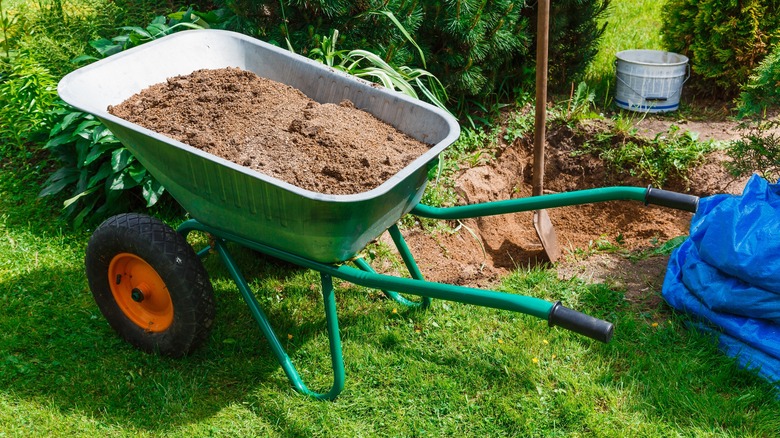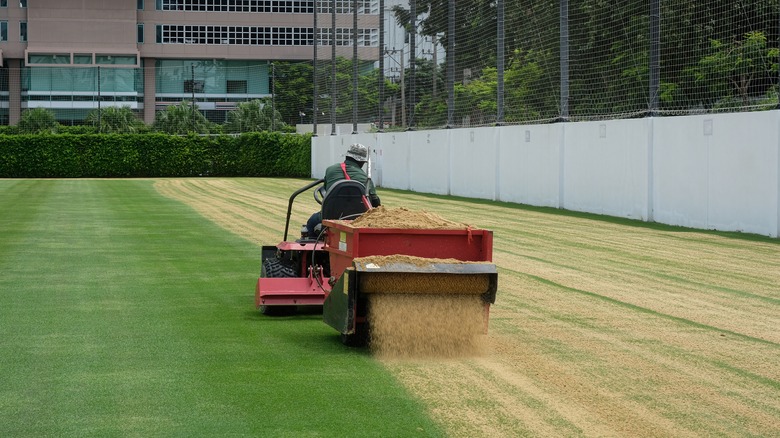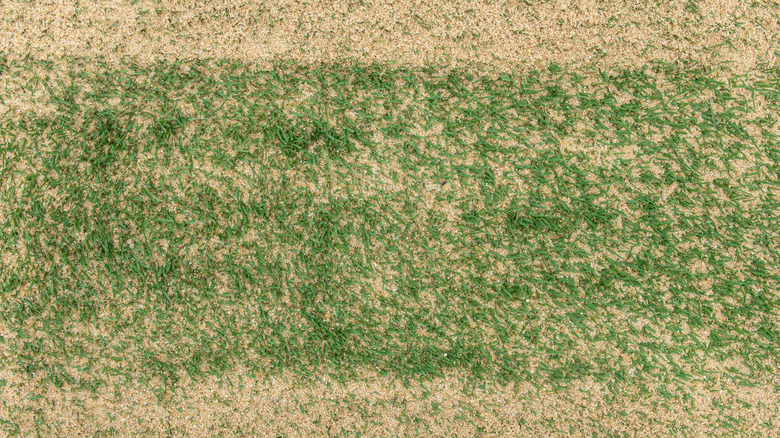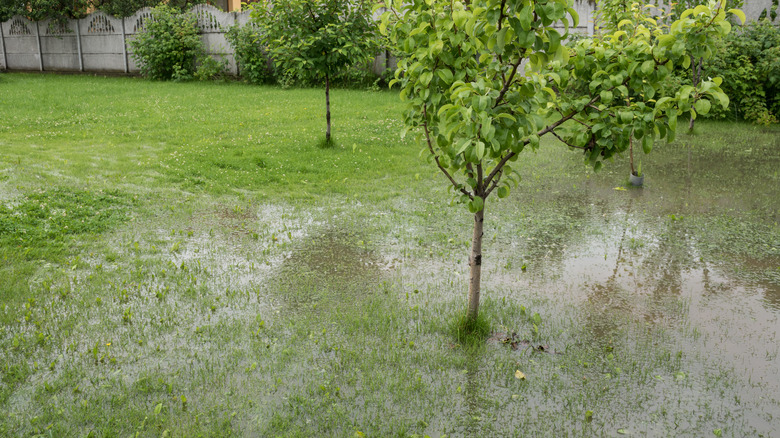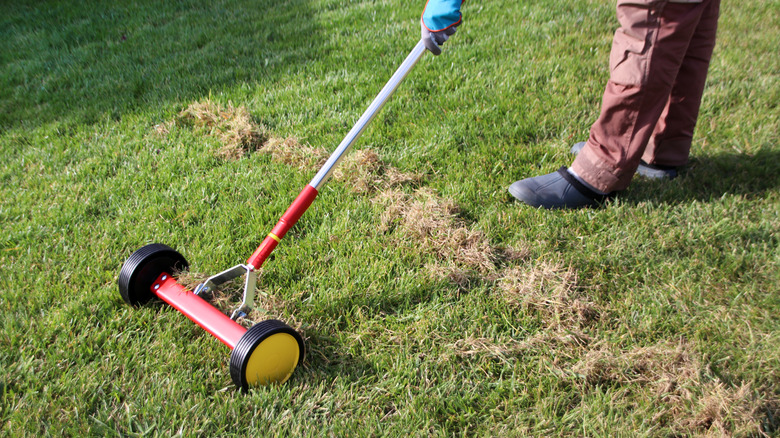5 Reasons Why You Should Add Sand To Your Lawn
When fine weather eventually comes around, enjoying your time on the lawn is an excellent way to spend your weekends. This is particularly true if you have a healthy, green lawn that looks inviting from afar. Lawns that are well-taken care of have many benefits other than a beautiful appearance, for instance, preventing soil erosion and flood control, via the University of Minnesota Extension. While there are many ways of ensuring your lawn is healthy and luscious all year round, the benefits of sand application are often not discussed enough.
Top dressing the lawn with a layer of sand is common on golf courses, and employing the same technique will do a lot of good for the yard. The application of soil to the lawn is often controversial since some argue that it can do more harm than good. While this is true, it is also worth mentioning that careful application of sand to the lawn is also quite beneficial in certain circumstances. So if you are wondering how to best use sand to improve the health and appearance of your lawn, this post is for you. Stick around to find out exactly how you can use sand the right way on your lawn.
1. To level your lawn
Over time, some areas on the lawn can become uneven, causing bumps, dips, or even depression which can be rather unsightly. This is a common occurrence in most lawns that is usually caused by freezing and thawing, not to mention other natural events that you have no control over, via Iowa State University Extension and Outreach. The good news is that the less extreme cases of rough lawns are easily fixable by topdressing with sand. This solution is beneficial for shallow unevenness, and topdressing your unleveled turf with sand is among the cheapest solutions.
Remember, sand is easily accessible and is often a DIY task that won't require additional labor fees. However, before spreading sand all over your garden, experts agree that the suitable composition for the topdressing soil should be sand and top soil in equal measure. Getting the balance right is crucial because too much sand causes water to drain fast and might dry out the grass. Scatter this mixture over the low-lying areas on your lawn to achieve an even surface.
2. To protect the lawn from frost and snow
Winter is a difficult season not only for humans but for your turf as well. Usually, when the lawn is left to its own devices, it can withstand most of what Mother Nature has to bring during the cold season. However, not all winters are the same. Therefore, a lot can happen, especially if the grass doesn't get the chance to adjust to the temperatures on time. You might not know this, but winter's effect on your lawn significantly affects how healthy it will be when spring arrives. For this reason, giving your lawn the best fighting chance against the frigid winter conditions is essential.
One way you can get your lawn ready for winter is by topdressing with sand to provide some protection to the crown against frost and snow. However, you need to be precise with your timing. Ensure your lawn is in good health and topdress with sand as close to the onset of winter as possible, mentions Lawns for You. While this might not be necessary every winter, it is still the best chance you can give your lawn to survive even the worst of frost.
3. To improve soil drainage
Every homeowner knows that water is vital for growing healthy grass. However, too much water in the yard causes the exact opposite of what you are trying to achieve. So if you notice that water takes too long to drain after episodes of rain, then you need to be concerned. Stagnant water in the yard is the perfect breeding ground for mosquitoes. Moreover, water will prevent air from reaching into the soil, eventually causing the plants to die. One way to improve the soil drainage in your yard is by topdressing with sand, which will help break down the soil structure and eventually improve the drainage.
However, My Lawn Tips mentions that sand should not be used to topdress clay soil because it binds the clay even further, creating a concrete-like structure. The University of Illinois at Urbana-Champaign recommends using organic matter to break up and improve the soil for better drainage. Another point worth mentioning is that sand will not provide nutritional value to your grass, so you must give adequate fertilizer right after. Remember, improving the soil drainage will not happen overnight; it is a continuous process requiring commitment and consistency over a long period.
4. To reduce thatch buildup
Every homeowner would want their lawn to be lush and soft enough to walk bare feet during the hot summer months. Unfortunately, this isn't always possible. The development of thatch on the lawn quickly messes up the beautiful grounds making it quite challenging to walk on without shoes. The formation of thatch on the lawn is a natural phenomenon that mainly occurs when the grass produces debris that is hard to decay and disintegrate, for instance, the fibers of vascular tissues or grass crowns.
Over time, they build up into an intermingled collection of dead and living substances collecting between the soil surface and the green grass vegetation. If left untreated, it can turn into a breeding ground for fungi causing lawn diseases, via the University of Massachusetts Amherst. The standard remedy to thatch buildup is raking and reseeding. However, if the thatch has accumulated for long, raking might not do more harm than good. The University of Florida Extension recommends using sand to topdress the soil as the best biological thatch control.
5. Use sand to cover tree roots
Ideally, exposed tree roots on the lawn should not be covered; however, leaving them out in the open can lead to damage, not to mention the unsightly appearance that most homeowners don't like. Moreover, tree roots that make their way to the surface are often large, making mowing the lawn difficult, and they can easily damage the lawn mower blade setting you back a couple of dollars in repairs. One way of ensuring you protect your yard equipment and avoid damaging the plant roots is by covering those that emerge to the surface. While covering them with mulch is often recommended, some homeowners prefer the appearance of soil over plant roots.
Before dumping soil over tree roots, you must be careful not to prevent oxygen from getting to the roots. In this regard, consider mixing topsoil and sand in equal measure. The sand will add porosity to the mixture, allowing oxygen to go right through. Another viable option for the root problem in the yard is pruning them. However, while removing the exposed tree roots might seem like a good idea, it can easily destabilize the tree. Davey recommends not pruning more than 15% of the roots that get to the surface.
